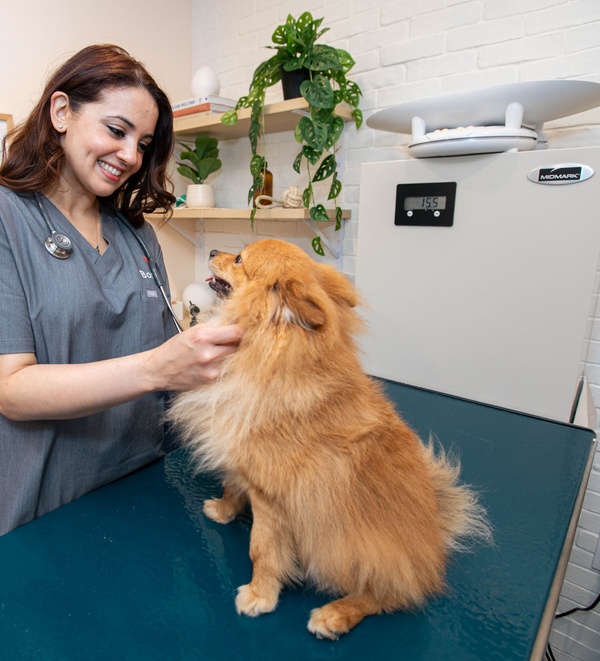
Dog Rash: Common Causes, Symptoms, and Treatments
Skin problems are one of the most common issues that veterinarians treat. Rashes, itchy skin, or other skin issues can be very uncomfortable and interfere with a dog’s favorite activities, not to mention their sleep schedule. Fortunately, with the right treatment plan, symptoms can often be eliminated, or at least minimized.
Rashes and other skin ailments can be caused by a variety of things, including allergies, parasites, underlying medical conditions, and even behavioral issues like boredom or stress. For the best treatment, it’s helpful to determine what caused the rash in the first place.
Here are some important things to know about dog rashes.
Causes of Dog Rash
While searching online, it’s easy to find many pictures of dogs with skin rashes or lesions. And, though this may be helpful for identifying an issue that needs to be treated, it’s not possible to determine what caused a dog’s rash or skin problem simply by the way the rash looks.
There are many possible causes of skin problems, all of which can cause similar symptoms. Here are some of the most common:
Fleas and flea allergy dermatitis (an allergic response to flea bites that causes extreme itchiness and commonly leads to skin infections).
Allergies. Most commonly, this includes environmental/seasonal allergies, also known as atopy. Food allergies or contact allergies (from plastic food bowls, for example) can also occur but are less common.
Contact irritation (shampoo, home cleaning products, a collar that chafes the skin, etc.).
Skin parasites such as mites/mange, ticks, or lice.
Medical conditions such as hormonal imbalances, autoimmune diseases, or other underlying issues.
Obsessive chewing or licking behavior due to stress or boredom.
Anything else that can affect the skin, such as skin growths, matted fur, sunburn, poison ivy, poor nutrition, insect bites, dry skin, etc.
Bacterial infections. Primary infections are possible, but more commonly, bacteria that normally live on the skin become opportunistic and overgrow due to disruption in the skin’s protective barrier secondary to rashes or wounds.
Fungal infections. These are usually opportunistic yeast infections that occur due to disruption of the protective skin barrier. However, less commonly, other fungi (including ringworm infection that is much more common in cats than in dogs) can occur.
Dog Rash Symptoms
Dog rash can happen on any part of the body, but it’s especially common to see dog rashes on the belly, groin area, underarms, and paws. Ear infections are also common.
Dog rashes may present in a number of different ways. Your dog probably won’t show all of these symptoms at the same time, but you might notice one or more of the following:
- Redness of the skin.
- Itchiness (chewing or scratching at the skin or ears, or rubbing against the floor, furniture, or people).
- Excessive hair loss, dull fur, or bald patches.
- Flaky skin, dander, or oily skin.
- Bumps, pustules (pus-filled bumps, similar to pimples), scabs, crusts, or wounds of the skin.
- Hot spots, or moist, inflamed skin wounds caused by a dog repeatedly licking, chewing, or scratching the area.
- Head shaking (for ear infections).
- With repeated skin problems, chronic changes to the skin may occur, such as thickening, permanent hair loss, or darkening of the skin.
- With allergic reactions, hives or swelling might be noticed (facial swelling or an allergic reaction accompanied by other symptoms like vomiting and diarrhea, collapse, or difficulty breathing, is an emergency that requires immediate veterinary treatment).
Depending on the underlying cause, additional symptoms might occur. For example, allergies might affect the skin and also cause digestive upset (although skin problems can be the only symptom), and a hormonal imbalance might cause both skin symptoms and an increase in urination.
Figuring Out What’s Causing Your Dog’s Rash
To provide the most appropriate treatment, it’s important to figure out what caused a dog to have a rash in the first place.
In addition to doing a full physical exam and talking to you about possible allergens or exposures, a veterinarian may recommend diagnostic tests such as…
- A swab of the skin and ears, to look for microscopic parasites, yeast, and bacteria.
- A skin scrape, which is a gentle scrape of the top layer of the skin to look for microscopic skin mites.
- A food trial to evaluate for food allergies. This is a strict dietary trial on a type of dog food that is unlikely to cause an allergic reaction in your dog (the specific food will depend on your dog’s dietary history), and it is considered to be more accurate than blood testing for food allergies. Your vet team will give detailed instructions.
- Allergy testing for environmental allergies. This could mean a blood test (more common) or skin testing done under anesthesia.
- If indicated, additional tests such as bloodwork, radiographs or ultrasound, or a biopsy of the affected skin will be recommended.
Usually, diagnostic testing is done in a stepwise manner, starting with a skin/ear swab and skin scrape. More advanced or invasive tests are recommended if an underlying disease (such as a hormonal imbalance) is suspected, if a dog doesn’t improve with standard treatment, or when initial testing doesn’t provide an answer as to what is causing the skin issue.
SEE ALSO: Urgent Care Vs. Emergency Care: How to Know the Difference
Treatment for Dog Rash
The answer for how to cure dog rashes depends on what caused the rash in the first place. Symptoms will need to be addressed, too, e.g. medications to relieve the itch. However, when symptoms alone are treated without addressing the underlying cause, the problem might come right back.
Treatment for the underlying cause might mean parasite treatments, a special diet for allergies, medications for an underlying medical condition, or other specific treatments as indicated.
For contagious conditions (such as Sarcoptic mange or a ringworm fungal infection), the vet team can offer advice on preventing the spread of the infection to people and other pets.
Regardless of the underlying cause, many of the following treatments are commonly used to provide relief and allow the skin to heal:
- Treatment for bacterial or yeast infections. While these infections usually occur secondary to the skin rash (opportunistic infections), their presence can cause discomfort and delay healing, so it’s important to treat them.
- Medications to relieve itch and inflammation. Commonly, this includes steroidal medications (such as prednisone, cortisone, etc.) given as an injection, pill, or topical cream or ointment. Newer medications for itchy skin are also available at most veterinarians’ offices or by veterinary prescription.
- Antihistamines such as Benadryl. Antihistamines are most effective at preventing allergic reactions rather than healing symptoms, but they may still be useful in the treatment plan. They may also be recommended for future preventive use, to be administered at home during allergy season, for example.
- Ear cleanings and ear medications. The ear flaps and ear canals are an extension of the skin, so they may experience similar symptoms (redness, irritation, and infections), especially with allergies.
- Wound care. Many dogs present with moist or oozing wounds such as hot spots, and the fur might be matted over top of the wound and stuck to it. The veterinary team will thoroughly clean the area, which includes clipping the fur so it’s easier to monitor the area and keep it clean at home.
- An Elizabethan collar to prevent a dog from reaching the area if they are relentlessly licking or chewing. This gives the skin a chance to heal.
- Medicated shampoos, creams, ointments, or sprays.
- Skin health supplements, which may include omega fatty acids, vitamin E, or other formulations.
- Referral to a veterinary dermatologist may be recommended for dogs with severe skin problems or skin issues that don’t respond well to standard treatments.
For chronic issues such as allergies, a cure isn’t possible―instead, treatment focuses on managing symptoms and minimizing flare ups.
Home Remedies for Dog Rash
Check with your veterinarian before giving any medication or supplement at home, to be sure it’s safe for your pup. Some substances can be toxic or harmful, including “dog-safe” medications and supplements if they are given at the wrong dosage.
If your dog’s rash is severe/uncomfortable, gets worse, comes back after a successful treatment, or doesn’t heal up after a few days of home treatment, it’s important to schedule a visit with your veterinarian.
With that in mind, sometimes minor issues can be treated at home. Home care may include…
- Skin supplements formulated for dogs.
- Antihistamines such as Benadryl. Check with your vet to see if this is right for your dog and what would be a safe dose. Avoid combination products (make sure it’s only Benadryl and doesn’t also contain a decongestant or other ingredients).
- Soothing shampoos (aloe or oatmeal based).
- Wiping off your dog’s paws and belly after a walk, to remove pollen and other potential allergens.
- Hydrocortisone cream is usually okay to apply for a few days directly on the rash. Just be sure your dog doesn’t lick and ingest it (an Elizabethan collar can help).
- Maintain regular grooming appointments for dogs who need their haircoat maintained or who shed a lot.
- Routine ear cleanings (with a dog ear cleaning solution) can help pups whose ears get affected.
- Quality flea prevention year round or based on your vet’s recommendation for your local area.
- Gentle antiseptic solutions (such as dilute chlorhexidine) for cleaning shallow wounds or infected skin.
- A humidifier in dry climates, to help prevent dry skin.
Need vet care ASAP? Book a visit.
Preventing Dog Rash
Some of the best ways to prevent dog rash are using a good quality flea prevention year round, feeding a nutritionally complete and balanced dog food, and maintaining your dog’s skin and coat with regular baths or professional groomings. The frequency of baths or haircuts varies depending on breed and lifestyle. Skin health supplements formulated for dogs may also be helpful, but check with your vet before giving any new medication or supplement.
Other preventive care depends on what caused your dog’s rash. For example, dogs with environmental allergies may benefit from antihistamines such as Benadryl during allergy season, skin health supplements, or having their paws and belly wiped clean after a walk to remove pollen. Dogs with food allergies may need a special diet. And dogs in dry climates may benefit from a home humidifier.
If you notice a skin problem, seek veterinary care as soon as you can. While skin rashes usually aren’t emergencies, early treatment is best.
Dog rashes are extremely common. But if a pet parent has knowledge of what to look for and seeks prompt treatment, most dogs get back to their normal selves pretty quickly.
With monitoring and the right treatment/prevention plan created with the help of your veterinarian, even dogs who are prone to long-term skin issues can have their symptoms minimized as much as possible and lead perfectly happy lives.
About the Author
